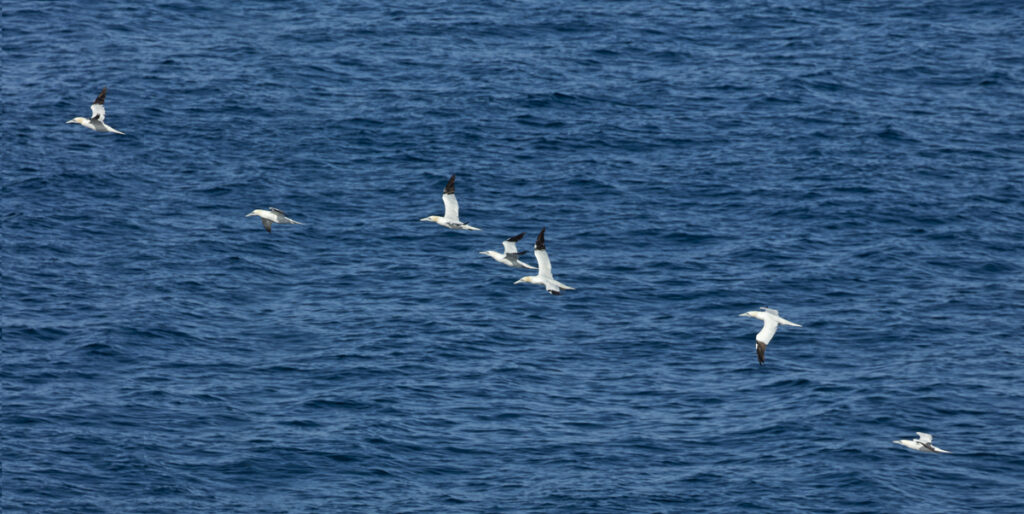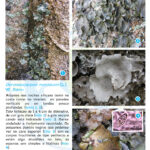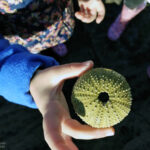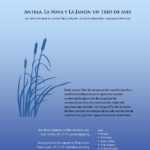
This 9 of march, 2023 is celebrated for the first time the “Galician Naturalism Day” (for commemorating the birthday of Martín Sarmiento, Spanish Benedictine writer and scholar) ADEGA, FEG, G.N. Hábitat, SGO, SGHN and Verdegaia want to report a perfect crime preparation before the Galician coasts
The marine area before the northwest of the Iberic peninsula is of extraordinary importance at a european, atlantic and even global level as a migratory passage and overwintering area for hundreds of thousands of seabirds from dozens of different species. Moreover, it is overflown for huge quantities of other birds on a frequent night-time migration between the east and west of Iberia, the north of Europe, Greenland or Canada. Because of this, the sea in front of Galicia has become one of many bottlenecks of bird passage with high conservationist responsibility of the named “East Atlantic Flyway”: the migratory route of the birds that fly twice a year from west Africa to north Europe and proximal areas.
For now, thanks largely to the disinterested work of several naturalists (who take a census of this birds’ activity, especially from Estaca de Bares, with information from over a century ago), science and citizens in general have known for a long time the amazing dimensions of the seabirds activity phenomenon in the waters most close to the shore. This event is even starting to become a tourist resource.
Sadly, it isn’t known much about the importance of the external waters yet (more than 14 miles far from the shore) both for seabirds and other birds, due to the fact that naturalists can’t get there. Only professional scientific investigation can reach that length through staff, ships, time and an appropriate budget. There are a lot of birds in those external waters, that is without a doubt. Therefore, it is urgent to know where, when and how they show up there. It is important to have in mind that seabirds are nomads, thus their distribution depends on multiple seasonal, meteorological and other several factors, which affect each species in a different way. Because of that lack of information, it only exists one “SPA” (Birds’ Special Protection Zone) in external waters —in the “Galicia’s Bank”, right where the birds’ presence was investigated—, while close to shore there are four ZEPA in Galicia, although they are not enough to protect the entire migratory corridor near shore.
POEM’S serious mistake
The recently approved POEM (“Plan de Ordenación del Espacio Marítimo” or Marine Espaces Reorganization Plan), suggests as “high potential zones for biodiversity preservation” a succession of areas close to shore in a unequal width area extended from Cabo de Peñas to the Rías Baixas, and a isolated zone just north from Estaca de Bares. The POEM recognises the importance the birds give to these zones in every place where investigations were made. But, avoiding the caution principle in a unacceptable way, the POEM includes a large part of those external waters in five “high potential zones for the development of the offshore wind energy”: one of them would be the one greater in size in all Spain and jointly they represent 54% of the surface of these zones in a state level. Furthermore, three out of five of those POEM’s zones are exactly in a narrow corridor that was left unprotected between the SPA, which protects the Estaca de Bares’s surroundings and the zone north from this same headland that the POEM himself recognises as “high potential zone for biodiversity conservation”.
This serious mistake can be reversed. Implementing the principle of “first, investigation and then, order”, the POEM should suggest studies and good sense and not placing those “potential zones for the offshore wind energy developpement” in places whose importance for the birds we can certainly suppose in sight of the investigations put into practice both in the Galicia’s Bank (SPA) and in this area north from Estaca de Bares.
The “perfect crime”: birds’s mortality in wind farms
It is well documented the birds’ risk of collision against the wind turbines is higher in places with a great number of migratory birds that, together with the overwintering ones, present bigger mortality rates than the resident birds.
When information about bird’s (and bats) mortality in the onshore wind farms was solicited, the Xunta de Galicia never provided any. Despite everything, we can always count with independent evaluations by the hand of naturalists and environmental associations.
But something like that won’t be possible for the offshore wind farms. There won’t be awkward witnesses for the big energetic corporations —with the exception of a pair of international ONG, no association has the human, technical and economical means for doing these researches in the high seas.
There will (almost) be no carcasses, because they will be quickly dispersed by ocean currents: from studies with oil slicks it is known that only 10% of the affected birds reach the seashore. The ingredients of a perfect crime.
Therefore, the undersigned associations demand that, in application of the principle of prudence, any planning of offshore wind farms in the northwest sector of Iberia should include, as a minimum, a complete prior study of the seasonal distribution of the populations of the different species of seabirds that use this area, as well as the land birds that transit it on their migrations. This study should be public and independent, and spread over several years, in order to obtain information on the wide inter-annual variability in the presence of the different species in these waters.
In this regard, it should be noted that, in addition to species threatened with extinction, species vulnerable to habitat modification, rare species due to their rarity or restricted distribution, the Birds Directive establishes that “other regularly occurring migratory species shall be subject to special measures concerning their habitat, taking into account the need for protection in the geographical sea and land area in relation to their breeding, moulting, wintering and staging areas in their migration areas”.
Some data on the presence of birds in the sea of Galicia
International importance as a migratory corridor for seabirds
The data available on this subject, taken by naturalists in the field, are only the “tip of the iceberg” of this phenomenon, which has reached international importance. Even in the absence of studies on bird movements in pelagic areas, or seasonal distribution atlases of the dozens of species presented here (which do exist in other European countries), the importance of the waters off Galicia in this regard is amply demonstrated.
Thus, only the distance visible from land passes through Galicia every year, in some cases in spring and autumn (on the way to and from their migrations), more than 50% of the world population of the northern gannet (Morus bassanus) and balearic shearwater (Puffinus mauretanicus); 9-10% of the world population of manx shearwater (Puffinus puffinus), cory’s shearwater (Calonectris borealis) and great skua (Catharacta skua); and over 1-5% of the world population of common scoter (Melanitta nigra), common tern (Sterna hirundo) and sandwich tern (Thalasseus sandvicensis)… and other species.
All this makes the migratory corridor of seabirds off the coast of Galicia one of the most important in Europe and the Atlantic, on a par with the Strait of Gibraltar or the English Channel.
Migrations of non-seabirds
But it also turns out that several recent studies highlight the existence of an important nocturnal migratory flow of non-marine birds (terrestrial and aquatic) over the Bay of Biscay. One example: in the case of land birds migrating at night between the north of Iberia (Galicia – Basque Country) and France alone, it was recently estimated that there are some 166 million individuals in spring and 215 million in spring and autumn. To these figures should be added those of waterbirds. And, of course, also those (both terrestrial and aquatic) that fly between the northwest Iberian Peninsula and areas such as the British Isles, Greenland, Canada, Siberia, the African coast…
A very important wintering area for seabirds
Although the wintering of seabirds in the outer areas of the Galician sea has never been studied, the consequences of the successive oil slicks that have devastated the Galician coastline reveal their unquestionable importance: suffice it to recall that in 2002 the Prestige affected, according to various studies, between 115,000 and 250,000 birds, many of them included in the Red Book of the Birds of Spain.
Ressources:
- East Atlantic Flyway http://datazone.birdlife.org/userfiles/file/sowb/flyways/4_East_Atlantic_Factsheet.pdf
- ZEPAs mariñas: https://www.miteco.gob.es/es/biodiversidad/temas/biodiversidad-marina/espacios-marinos-protegidos/red-natura-2000-ambito-marino/red-natura-2000-declaracion-lugares-ZEPA.aspx
Text translated by Lucía Villaverde Rey (student of the Degree of Translation and Interpretation of the University of Vigo)






